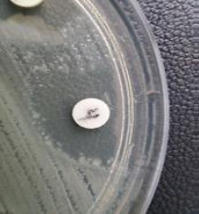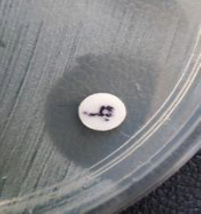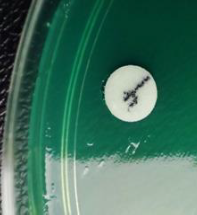Magnolia officinalis is a tree whose parts (bark, leaves, flowers) are characterized by a content-rich in phytochemical compounds of great interest nowadays. Modern medicine relies on the replacement of conventional treatments or the completion of treatment schemes with plant extracts rich in different phytochemical classes for greater efficiency and to reduce side effects. In this work, the oil was extracted from the leaves of Magnolia officinalis, which was characterized by GC-MS, highlighting the majority of compounds from the class of monoterpenes (linalool and linalool derivatives) and sesquiterpenes (caryophyllene). These compounds have been described from the point of view of the action they can exert in different conditions, highlighting the main mechanisms of action. Magnolia officinalis leaves were also characterized by macro- and microscopic analysis. The obtained oil was tested from the point of view of antimicrobial activity on gram-positive and gram-negative bacteria and was included in biocompatible capsules through a quick and cheap method called the coacervation method. The need to encapsulate the oil is given by the fact that the properties of Magnolia oil are lost over time if it is preserved as such and due to the low bioavailability in the case of oral administration, the encapsulated form solves all these inconveniences. Future perspectives are related to testing the bioavailability of the encapsulated Magnolia oil by oral administration of the capsules and testing their properties over time during storage.
Introduction
Magnolia species have been cultivated since ancient times in China, Korea, and Japan, later the interest in this tree has increased all over the globe, reaching Europe as well [1-3]. There are approximately 200 species of magnolia trees and in traditional medicine, the extract from different parts of the tree has been made and used in different pathologies such as digestive, respiratory, cardiovascular, bone pathologies, and especially those in the neural sphere (anti-stress, anti-anxiety, antidepressant), antioxidant, anti-inflammatory, anticancer, hepatoprotective, etc [4-6].
Magnolia officinalis is part of the Plantae regnum, division: Tracheophyta, class: Magnoliopsida, order: Magnoliales, family: Magnoliaceae, genus: Magnolia, species: Magnolia officinalis, and is characterized by the existence of extensive pharmacological properties due to its composition rich in monoterpenes, sesquiterpenes, phenolic compounds, flavonoids, neolignals (magnolol, honokiol), etc. [7, 8]. The chemical composition differs depending on the part of the plant that is taken in the study, so the medicinal properties vary [5]. The plant parts considered to be beneficial and with pharmacological properties due to their composition are bark, flower buds, and leaves [2, 9].
Thus, Magnolia officinalis bark extracts have been used in traditional Chinese and Japanese medicine for thousands of years for their sedative, antioxidant, anti-inflammatory, antibiotic, and antispasmodic properties. It is still commonly used as an herbal preparation [10]. Neolignans, especially magnolol, and honokiol, are the main compounds responsible for the beneficial properties of magnolia bark extract. The content of magnolol and honokiol varies depending on several factors, such as magnolia plant species, country of origin, plant parts used, and how the extract is produced [4, 10].
The bark mainly contains phenolic compounds, alkaloids, and essential oils. Magnolol, honokiol, and other phenolic compounds are the main active ingredients that have obvious pharmacological effects on the digestive, nervous, cardiovascular, and respiratory systems. In addition, it has anti-inflammatory, analgesic, antibacterial, antitumor, and antioxidant properties [11]. White flower buds contain large amounts of monoterpene hydrocarbons (MH), phenolic acids, aromatic amino acids, and monosaccharides, which are involved in the production of isoprene as a precursor of MH and in MH synthase activity. However, the levels of β-myrcene, an important MH compound, were higher in purple flower buds than in white flower buds, probably due to higher levels of threonine and relatively lower levels of some organic acids. It is believed to reflect the low acidity due to the low temperature. In addition, levels of stress-related metabolites such as oxygenated monoterpenes are also measured. The flowers of Magnolia officinalis bark also contain essential oils that have similar effects to the bark but with weaker functions. It is mainly used to treat heaviness in the spleen and stomach, bloating, chest discomfort, and upper abdomen [11]. The leaves also contain essential oils, flavonoids, polysaccharides, and chemical constituents with pharmacological effects, such as antibacterial, antioxidant, and vasodilator properties [12, 13]. The essential oil contains monoterpene hydrocarbons, monoterpenoids, sesquiterpenes, hydrocarbons, and sesquiterpenoids [14]. It is also rich in eucalyptol, beta-elemenene, linalool, beta-edumesol, methyl chavicol, caryophyllene, camphor, limonene, and alpha-pinene [8, 14]. The problem is, however, the method of administering the extracts or the volatile compounds extracted from these plants, so that currently an innovative method of administering them is being sought so that the existing active principles do not degrade along the digestive tract (in oral administrations) or during storage (at humidity, variable temperature, etc.) [15].
This paper brings to the fore the leaf of the Magnolia officinalis plant from which the oil was extracted and characterized in terms of composition and antibacterial properties. It also presented an innovative method of formulating capsules obtained through the coacervation process in which the essential oil was included, thus achieving an increase in the storage period and its oral administration (with increased compliance), masking the smell and very intense taste. The main therapeutic areas were also identified through the study of recent literature.
Macroscopic Characterization of the Leaf of the Plant Magnolia officinalis
The macroscopic examination is carried out in the order of specifying the following elements: appearance (observed with the naked eye or with a magnifying glass compared with a known sample). The outer and lower appearance, the upper and lower face, the consistency, the hardness, and the appearance to the touch are established, size, color, and smell [16].
Microscopic Characterization of the Leaf of the Magnolia officinalis Plant
The microscopic study at the level of the vegetative organ was carried out by transversal section and this was done to highlight the secretory structures and the tectorial bristles characteristic of the species. The preparations are analyzed with the Optika B350 analysis microscope [17].
The Method of Obtaining the Essential Oil of Magnolia officinalis Leaves
The aerial parts of the plant Magnolia officinalis (50 g) were subjected to oven drying at a temperature of 65°C until constant weight. The uprooted plant was pulverized by crushing and used to obtain Magnolia officinalis volatile oil using a Soxhlet apparatus. Petroleum ether was used as a solvent to extract the oil. The Soxhlet apparatus was run at 65°C for 8 hours. After this, the solvent was evaporated using the Heidolph Rotary Evaporator, Laborota 4000, for 45 minutes at 100 rpm [6, 15, 16].
Characterization of Essential Oil from Magnolia officinalis Leaves by GC-MS
Sample preparation: 0.100 ml of oil was dissolved in 1 ml of ethanol (dilution 1:10). GC-MS analysis of the volatile oil from Magnolia officinalis leaves was performed using a Thermo GC-MS (Model Trace 1310 ISQ 7000) equipped with an HP-5MS capillary column. For GC-MS spectroscopic detection, an electron ionization system with an ionization energy of 70 eV was used. Helium served as the carrier gas with an injection volume of 1 µL. The mass transfer line and injector temperature were set at 220 °C and 290 °C, respectively. The oven temperature was programmed at 45 °C for 1 minute, increased, and maintained at 250 °C for 5 minutes [18].
The Antimicrobial Activity of Magnolia officinalis Essential Oil
The microbial strains were represented by a gram-positive bacterium: Staphylococcus aureus ATCC 25923 – LOT and 2 gram-negative bacteria: Pseudomonas aeruginosa ATCC 497757 – LOT and Escherichia coli – ATCC 25922 – LOT. Mueller-Hinton plates were seeded within 15 minutes of calibration using new, sterile swabs. The antimicrobial activity of magnolia volatile oil was investigated by the standardized diffusimetric (Kirby-Bauer) seeding method. Microbial suspensions were prepared in sterile 0.9% saline and adjusted as inoculum to a final concentration of 0.5 McFarland standard. A volume of 20 mL of Mueller-Hinton agar for bacterial strains was inoculated with 20 μL of microbial suspension and then poured into a Petri dish. The dishes were left at room temperature for 15 minutes to allow the culture medium to solidify. Each 6 mm diameter paper disc was impregnated with 40μg of the sample solution (Magnolia officinalis essential oil) and then manually applied to the surface of agar plates inoculated with microorganisms. Ciprofloxacin (5μg/disc) and Gentamicin (10μg/disc) were used as positive reference standards to determine the sensitivity of gram-positive and gram-negative bacterial species. The dishes were kept at 4ºC for 2h to allow diffusion and then incubated for 24h at 37ºC. Antimicrobial activity was determined by measuring the diameters of inhibition zones [19, 20].
Microcapsule Formulation with Magnolia officinalis Oil Included
The microcapsules were formulated using an easy method, namely the coacervation method. This method involved the use of simple elements such as balsamic vinegar, agar-agar, olive oil, and the essential oil obtained from the leaves of Magnolia officinalis to be incorporated. In short, to obtain the microcapsules, 100 g of balsamic vinegar, and 2.5 g of agar-agar were weighed on an electronic balance. After the mixture is homogenized, the mixture is boiled to activate the polymer, and 2 g of magnolia oil is added drop by drop, stirring continuously [21].
To obtain the actual microcapsules, a 20 ml syringe was used, with the help of which the hot mixture was dripped into a vessel with a wide opening containing the olive oil that had been kept cold (4˚C) for 30 minutes. After the formation of the microcapsules, they are extracted from the oil and washed with distilled water (Figure 1). To increase the stability during storage, they were subjected to drying, until the constant mass [22, 23].
|
|
|
Figure 1. Obtaining microcapsules with Magnolia officinalis essential oil. |
Results and Discussion
Following the macroscopic analysis, we identified the organoleptic elements as those described in the specialized literature [6, 10, 15]. Thus, the leaves have smooth edges, they can be green throughout the year or fall off. The length of the leaf can be between 12-20 centimeters and the width can be up to 12 centimeters.
|
|
|
|
a) Macroscopic analysis of leaves |
b) Transverse section of the leaf |
|
Figure 2. Macroscopic (a) and microscopic (b) analysis of the Magnolia officinalis leaf. |
|
Following the microscopic analysis, the secretory structures as well as the tector bristles were highlighted in the cross section of the leaf. The upper and lower epidermis of the plant and the assimilative tissue were also observed throughout the section.
The epidermis consists of a single row of large cells with a highly developed cuticle covered with wax. From place to place on both sides, smaller, unevenly thickened stomatal cells are observed, placed below the level of the epidermis, accompanied by accessory cells.
On the section of the leaf, the upper and lower epidermis can be seen. The upper epidermis consists of a layer of cells corresponding to the upper side of the leaf, the lower epidermis consists of a layer of cells corresponding to the lower side of the leaf. The core occupies the space between the two epidermises. The cells below the upper epidermis are elongated and placed perpendicular to the epidermis. They contain many chloroplasts with chlorophyll arranged in strings. These cells form the assimilation tissue, which is the place where the main function of the leaf is carried out most intensively. The epidermis is similar to the stem; stomata can be found, covered with tector brushes, rarely glandular. Oil is stored in the secretory structures.
Extraction and Characterization of the Magnolia officinalis Essential Oil by GC-MS Analysis
Following the extraction process described in section 2.3, 4.6 mL of volatile white-yellowish oil, with a strong specific smell, was obtained. The volatile oil was collected and stored in the dark, in the cold, before subjecting it to gas-chromatographic analysis.
Following the GC-MS analysis, the compounds presented in Table 1 and Figure 2 were identified and quantified.
Table 1. The main compounds were identified by GC-MS analysis of the oil obtained from Magnolia officinalis leaves.
|
No. |
Denumire substanta |
RT (min) |
Peaknumber |
|
1. |
Acid 2-metil-valeric |
7,50 |
28 |
|
2. |
3-Thujene |
7.56 |
29 |
|
3. |
3-Carene |
7,73 |
31 |
|
4. |
1S-alfa-Pinene |
7,81 |
32 |
|
5. |
Camphene |
8,08 |
33-34 |
|
6. |
4-Metilen-1-(1-metiletil)-biciclo(3,1,0)hexan |
8,76 |
36 |
|
7. |
beta-Pinene |
8,84 |
37 |
|
8. |
beta-Myrcene |
9,15 |
39 |
|
9. |
o-Cymene |
9,98 |
48 |
|
10. |
D-Limonen |
10,10 |
49 |
|
11. |
Eucaliptol |
10,17 |
50 |
|
12. |
cis-Linalool oxide |
11,20 |
55 |
|
13. |
trans-Linalool oxide |
11,28 |
56 |
|
14. |
Linalool |
11,75-12,54 |
59-81 |
|
15. |
endo-Borneol |
13,67 |
89 |
|
16. |
trans-Linalool 3,7-oxide |
13,78 |
90 |
|
17. |
Terpineol |
14,21 |
93 |
|
18. |
19,41-19,58 |
134-140 |
Following the analyses carried out, it was found that in magnolia oil there was a significant amount of monoterpenes and monoterpenoids, the largest amount being represented by linalool (30%). It was also identified in the form of derived compounds of the type cis-linalool oxide, trans-linalool oxide, and trans-linalool 3,7-oxide. The peak corresponding to number 1 can be seen in Figure 3.
Linalool is a natural monoterpene that is widespread in the volatile oil of many plants including Magnolia officinalis. It is a low molecular weight acyclic monoterpene tertiary alcohol with a hydroxyl functional group [15]. This grouping gives the compounds polarity, making them biologically active. This monoterpene alcohol exhibits antioxidant, anti-inflammatory, and antitumor activities and exhibits antibacterial activity against Staphylococcus aureus, Pseudomonas aeruginosa, and Escherichia coli [15, 24].
Linalool refers to two antagonists of terpene alcohol that occur naturally in many flowers and plants. It also has many commercial applications, most of which rely on its pleasant smell. A colorless oil, linalool is classified as an open-chain monoterpenoid. In plants, it is a metabolite, a volatile oil component, an antibacterial agent, and an aromatic compound [25].
|
|
|
Figure 3. Chromatogram of Magnolia officinalis essential oil. |
It can be seen in Figure 3 that the peak related to number 2 is the existence of another majority compound (25%), Caryophyllene which is part of the category of sesquiterpene compounds, having a bicyclic structure. It is a compound known in the literature as having anti-inflammatory properties and a strong anticancer agent. Also, this sesquiterpene compound is recognized for its powerful antioxidant properties, blocking the formation of reactive oxygen species, and even for its re-epithelializing effect [26].
Testing the Antimicrobial Activity of Magnolia officinalis Oil
The testing of the antimicrobial activity of Magnolia officinalis oil was carried out using antibiotics such as Ciprofloxacin 5µg and Gentamicin 10µg as controls. Magnolia officinalis oil was applied in a volume of 40 µl and the diameter of the inhibition zone is shown for each sample separately in Figure 4.
|
|
Staphylococcus aureus |
Escherichia coli |
Pseudomonas aeruginosa |
|
|
 |
 |
 |
|
|
Inhibition diameter (mm) |
||
|
Magnolia oil 40µl |
13 |
11 |
7 |
|
Ciprofloxacin 5µg |
27 |
30 |
27 |
|
Gentamicin 10 µg |
24 |
20 |
18 |
|
Figure 4. The results of testing the antimicrobial activity of Magnolia officinalis oil compared to two known antibiotics, using the diffusion method. |
|||
It can be seen in Figure 4 that the strongest inhibitory activity was manifested in the gram-positive bacterium Staphylococcus aureus (13mm). The antibacterial activity is mainly due to the composition rich in linalool, which is known in the literature for its antibacterial properties [15]. Antibacterial and antifungal properties of linalool have also been reported in the literature on Candida albicans, Aspergillus brasiliensis, Porphyromonas gingivalis, Prevotella nigrescens, Aggregatibacter actinomycetemcomitans, Streptococcus sobrinus. Also, Duarte et al. reported the antibacterial properties of linalool on strains of Campylobacter jejuni and Campylobacter coli.
Microcapsule Formulation with Magnolia officinalis Oil Included
The need to include Magnolia officinalis oil in vehicle and transport systems is given by its chemical composition rich in linalool and caryophyllene compounds with low bioavailability and solubility in the case of conventional administration. Thus, by including the oil in different transport systems such as liposomes, nanocapsules, microcapsules, the result is an increase in bioavailability and treatment compliance, but also an increase in shelf life (the encapsulated compounds are protected from environmental factors that lead to their degradation) [27]. Different transport systems are mentioned in the literature that have incorporated extracts or oils rich in linalool such as cyclodextrins (to increase bioavailability in oral treatment), polybutylcyanoacrylate nanocapsules by emulsion polymerization (to mention properties for the storage period), nanoparticles lipid (to improve bioavailability at the skin level for example), etc [15].
In this work, the inclusion of Magnolia officinalis oil in microcapsules was achieved innovatively, using the coacervation method, a method that requires biocompatible materials, cheap and difficult to procure. The advantage of this method, in addition to those listed above, is the execution time, which is very short (approximately 30 minutes). In Figure 5a, it can be seen the microcapsules with Magnolia officinalis oil obtained by the coacervation method. The shape is the round or spherical characteristic, the specific color of the materials used in the formulation. In Figure 5b, the microcapsules can be seen after the drying process, having an irregular shape due to the dehydration process that took place.
|
|
|
|
a) |
b) |
|
Figure 5. Microcapsules with Magnolia officinalis oil before (a) and after drying (b). |
|
After obtaining the capsules with Magnolia officinalis oil and drying it, better preservation was observed over time (thereby protecting the oil against environmental factors such as light, temperature, humidity) so that in the following studies their effects will be tested following oral and cutaneous administration.
Medical Uses of Magnolia officinalis Oil
Taking into account that the majority of the compounds highlighted by GC-MS analysis were linalool and linalool derivatives, respectively caryophyllene, they are highlighted in this subchapter in terms of their therapeutic properties. Most of the therapeutic activities of these compounds are common, being demonstrated in vitro and in vivo [15, 28, 29].
Antioxidant and Antimicrobial Capacity
In general, in the studies found in the literature, the antioxidant properties of extracts from different Magnolia species are tested by conventional methods such as FRAP, CUPRAC, and DPPH, thus highlighting the increased antioxidant capacity. The increased antioxidant capacity will generate the decrease of free radicals in the body by neutralizing them, thus these compounds are involved in the prevention of oxidative stress or cancerous conditions. The antimicrobial properties were demonstrated on gram-positive and gram-negative bacteria such as Pseudomonas aeruginosa, Escherichia coli, and Staphylococcus aureus, the antifungal properties were also highlighted on Candida albicans according to the authors Pereira et al. (2018) [15, 30].
Anti-inflammatory Activity
The anti-inflammatory properties are due to the involvement of linalool and its derivatives in the process of producing inflammation, which is stopped by inhibiting TNF-α and interleukin-6 [31]. According to the in vitro studies on different types of cells, linalool also blocks the inflammatory NF-kB pathway and the mitogen-activated protein kinase pathway, thus demonstrating its anti-inflammatory properties [15]. A series of studies were carried out in the case of lung inflammation on an animal model highlighting the anti-inflammatory activity of the terms through the ability to inhibit inflammatory factors such as TNF-α, IL-6, IL-1β, IL-8. It has also been demonstrated that monoterpenes intervene in the synthesis of nitric oxide, inhibiting it, and thus reducing the inflammatory process [32].
Anticancer Activity
The anticancer activity of linalool and caryophyllene is due to the mechanism of action on malignant cells, preventing their differentiation and proliferation, and ultimately dictating their apoptosis [33]. Also, having a strong neutralizing action of reactive oxygen species, it can function as a preventive factor against the appearance of malignant tumors. It is demonstrated by Cheng et al. (2017), that the free radical neutralization mechanism of compounds such as linalool is mainly based on the inhibition of superoxide dismutase 2 activity [34]. All these mechanisms of action have currently been proven in vitro studies on human cells of different types such as cells specific for breast cancer prostate, cervix, leukemia, and colon cancer. At the same time, monoterpenes can intervene selectively making the difference between cancerous cells and normal ones, the latter being protected and in malignant ones, it induces the degradation of cellular DNA leading to cellular apoptosis [35].
Antihyperlipidemic and Antiobesity Activity
Linalool also has antihyperlipidemic properties acting by inhibiting the process of lipid formation in the body, anticholesterolemic and antiatherosclerosis action, having a protective role on blood vessels. Caryophyllenes act against obesity, fatty liver, and cardiovascular diseases, having direct activity on cannabinoid receptors (CB2) and on peroxisomes [15, 36].
Antinociceptive Activity
Most of the studies that proved the antinociceptive effect of monoterpenes (linalool and linalool derivatives) were carried out on animal models, with known doses of these compounds being injected into the paw. Thus, Kuwahata et al. for example, they demonstrated that the administration of linalool alone or in combination with other drugs used in pain therapy showed increased nociceptive activity [37, 38]. The supposed mechanism is that linalool reduces the activation of spinal extracellular signal-regulated protein kinase. For these reasons, linalool can be used as an antinociceptive alone or in combination with other medicinal substances in acute or chronic pain or even in carpal tunnel syndrome [39].
Antidepressant and Anxiolytic Activity
The antidepressant and anxiolytic properties of Magnolia officinalis oil are due to its rich content in linalool, a compound that acts by inhibiting sodium channels at the neuronal level and by interacting with serotonin A1 receptors and α2 adrenergic receptors respectively [40, 41]. Also, the administration of linalool led according to the author's Cheng et al. when the level of dopamine, serotonin, and norephedrine decreases [34].
Conclusion
In conclusion, this paper highlights the medical properties of the compounds found in Magnolia officinalis oil and its antimicrobial properties. The plant material from which the essential oil was extracted is the leaves, these being also characterized from the point of view of the botanical structures characteristic of the species through macroscopic and microscopic analysis. The chemical composition was qualitatively and quantitatively characterized by GC-MS analysis and the main compounds highlighted in a percentage of 30% were the monoterpenes linalool and its derivatives and in a smaller amount 25% sesquiterpenes of the caryophyllene type. The antimicrobial capacity of the oil obtained from Magnolia officinalis leaves was demonstrated on gram-positive and gram-negative bacteria. Considering that the properties of the essential oil deteriorate during storage but also along the digestive tract in the case of oral administration, it is necessary to include it in delivery systems such as microcapsules. Thus, it was possible to formulate microcapsules with encapsulated oil using biocompatible, cheap materials, and an easy and fast method based on the coacervation process. The obtained oil capsules have a spherical-round shape and a characteristic shape and after dehydration an irregular shape, thus managing to mask the intense taste and smell of the oil, but also to increase the storage period of the oil without it losing its therapeutic properties.
As a future perspective, we want to test the stability over time of the capsules with Magnolia officinalis oil included and to test in vitro the controlled release in different simulated liquids to develop a controlled release system in case of its oral administration.
Acknowledgments: None
Conflict of interest: None
Financial support: None
Ethics statement: None
